Carole Lombard
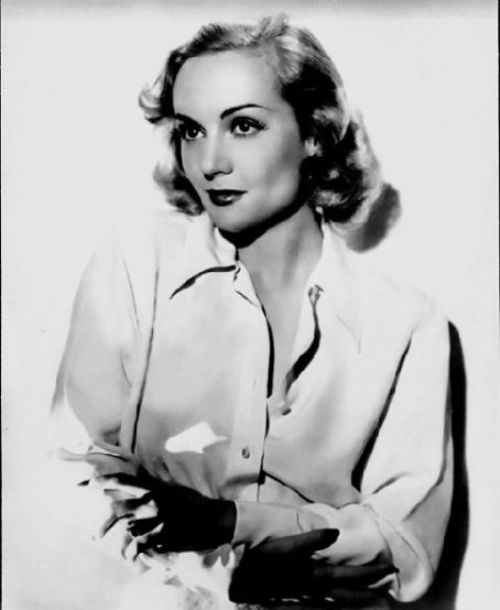
“She gets up too early, plays tennis too hard, wastes time and feeling on trifles and drinks Coca-Colas the way Samuel Johnson used to drink tea. She is a scribbler on telephone pads, inhibited nail-nibbler, toe-puller, pillow-grabber, head-and-elbow scratcher, and chain cigarette smoker. When Carole Lombard talks, her conversation, often brilliant, is punctuated by screeches, laughs, growls, gesticulations and the expletives of a sailor’s parrot.”
~Life Magazine, 1937
Stats
Born Jane Alice Peters on October 6, 1908 in Fort Wayne, Indiana, to Frederick Peters and his wife, Elizabeth Knight, “Bessie”. Two older brothers, Frederick and Stuart.
5’4, blonde, blue-eyed
Quotes
“I’ll work a few more years, and then I want a family. I’ll let Pa be the star, and I’ll stay home, darn the socks and look after the kids.”
“Clark isn’t the happy-go-lucky, carefree man the public sees. He’s not had a very happy life and is inclined to be depressed and worried. I want to make it up to him if I can.”
“I don’t give a damn about me. I want to take care of my pappy; give him everything he wants.”
“We never do anything much, but we have a lot of laughs and Pa is relaxed and happy.”
Before Clark
Carole’s parents separated when she was six and Bessie moved with her children to California, for the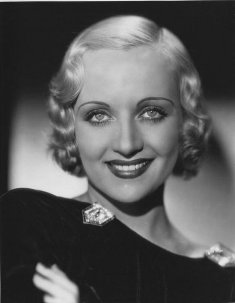 climate. Carole was soon discovered by a movie scout on the street, playing stickball with the boys. She made her first film appearance (as Jane Peters) in the 1921 film A Perfect Crime. She slowly worked her way up the movie business, changing her name to the more prestigious-sounding Carole Lombard (at first spelled “Carol”), She began to earn notoriety as one of Mack Sennett’s bathing beauties. Carole’s career was nearly shattered by a car accident in 1929, when glass from the windshield badly cut her face. She endured surgery without an anesthetic and although her scar can still be seen in some of her films and photographs, it didn’t seem to derail her career. By 1931, she was an up and coming starlet and had caught the eye of one of her costars, William Powell. They were married on June 26,1931. He was 38, she was 22. Although they seemed very much in love, their differences were too great: he was a homebody, serious and at times considered stuffy, while she was a “lounge lizard”, known for being the life of the party. Realizing their mistake, Carole made a trip to Reno and they were divorced on August 16, 1933. She then had a tumultuous romance with singer Russ Colombo, until his sudden death in 1934. That same year she had her breakout role, as loud and boisterous actress Lily in Twentieth Century, costarring John Barrymore. The film, considered to be the first screwball comedy, drew raves and cemented her as “The Queen of Screwball”. Her career took off, starring in hits such as The Princess Comes Across, Hands Across the Table and Nothing Sacred. She was nominated for an Oscar in 1936 for her role as zany Irene Bullock in My Man Godfrey, starring opposite none other than her ex-husband, William Powell. She gained another nickname as well, “The Profane Angel”, due to her use of salty language. She admitted privately that it was “a smoke screen” to set her on par with men. Most men were a bit scared of her, as she seemed like quite a handful, and she did not sleep around like many of her fellow actresses–Carole chose her man companions carefully.
climate. Carole was soon discovered by a movie scout on the street, playing stickball with the boys. She made her first film appearance (as Jane Peters) in the 1921 film A Perfect Crime. She slowly worked her way up the movie business, changing her name to the more prestigious-sounding Carole Lombard (at first spelled “Carol”), She began to earn notoriety as one of Mack Sennett’s bathing beauties. Carole’s career was nearly shattered by a car accident in 1929, when glass from the windshield badly cut her face. She endured surgery without an anesthetic and although her scar can still be seen in some of her films and photographs, it didn’t seem to derail her career. By 1931, she was an up and coming starlet and had caught the eye of one of her costars, William Powell. They were married on June 26,1931. He was 38, she was 22. Although they seemed very much in love, their differences were too great: he was a homebody, serious and at times considered stuffy, while she was a “lounge lizard”, known for being the life of the party. Realizing their mistake, Carole made a trip to Reno and they were divorced on August 16, 1933. She then had a tumultuous romance with singer Russ Colombo, until his sudden death in 1934. That same year she had her breakout role, as loud and boisterous actress Lily in Twentieth Century, costarring John Barrymore. The film, considered to be the first screwball comedy, drew raves and cemented her as “The Queen of Screwball”. Her career took off, starring in hits such as The Princess Comes Across, Hands Across the Table and Nothing Sacred. She was nominated for an Oscar in 1936 for her role as zany Irene Bullock in My Man Godfrey, starring opposite none other than her ex-husband, William Powell. She gained another nickname as well, “The Profane Angel”, due to her use of salty language. She admitted privately that it was “a smoke screen” to set her on par with men. Most men were a bit scared of her, as she seemed like quite a handful, and she did not sleep around like many of her fellow actresses–Carole chose her man companions carefully.
How They Met
Their exact meeting date has not been pinpointed exactly. They are both credited as extras in the 1925 film Ben Hur: A Tale of the Christ but it is not known whether or not they socialized off set.
 In 1932 they starred together in the Paramount film, No Man of Her Own. A modest success, it featured Carole as a small town librarian who falls head over heels for Clark, a card cheat. Carole was married to William Powell and Clark was preoccupied with British actress Elizabeth Allan, so no sparks flew off camera, although they were cordial. At the film’s wrap party, Carole presented Clark with a ten pound ham with his picture posted on it. Neither of them of them would have guessed that they would be in love just a few short years later!
In 1932 they starred together in the Paramount film, No Man of Her Own. A modest success, it featured Carole as a small town librarian who falls head over heels for Clark, a card cheat. Carole was married to William Powell and Clark was preoccupied with British actress Elizabeth Allan, so no sparks flew off camera, although they were cordial. At the film’s wrap party, Carole presented Clark with a ten pound ham with his picture posted on it. Neither of them of them would have guessed that they would be in love just a few short years later!
On February 7,1936, both attended a party at Jock Whitney’s house, to celebrate screenwriter Donald Ogden Stewart’s wife’s recent release from a sanitarium, jokingly called “The Nervous Breakdown Party”. Things did not start out well as Carole, as a joke, arrived in an ambulance. Attendants carried her on a stretcher and placed it in the middle of the room. Everyone gasped and gathered around. She jumped up, howling with laughter. Clark, there with Merle Oberon, was not amused and found the joke in poor taste. Clark and Carole got into a fight that ended with her stomping away from him, furiously proclaiming that he was a stuff shirt. Near the end of the party, Carole challenged Clark to a game of tennis. There they played, both in evening clothes, playing tennis until it was too dark to see (Carole beat him 8-0). Merle, irritated by being ignored, had someone else take her home and Clark didn’t even notice.
A couple months later, at the annual Mayfair Ball, Clark and Carole shared a dance. Holding her close,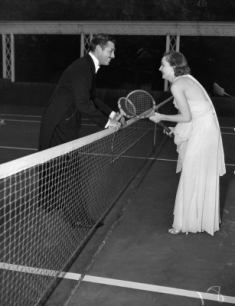 Clark realized she wasn’t wearing any undergarments. Taking this as a green light, he suggested they leave the party and go back to his hotel together. Carole laughed and said, “Who do you think you are, Clark Gable?” This angered him and he left the party. The next morning he awoke to the sounds of birds cooing in his bedroom. Carole had convinced a hotel worker to put them in there while he slept. Tied to one of the birds was a note that said, “How about it? Carole” From that point on, they became inseparable. For the next three years, they were one of Hollywood’s most glamorous couples. They attended the Academy Awards together, premieres and were the number one topic of the press. Carole grew anxious for marriage. She wanted the title and she wanted children. Biding her time waiting for Clark’s wife Ria to get a divorce, Carole went house shopping. She and Clark jumped at the chance to own director Raoul Walsh’s twenty acre ranch in Encino. It was everything they had wanted. Carole wrote a check for $50,000 and the house was theirs. Renovations began and the couple waited until the day they could occupy the house as husband and wife.
Clark realized she wasn’t wearing any undergarments. Taking this as a green light, he suggested they leave the party and go back to his hotel together. Carole laughed and said, “Who do you think you are, Clark Gable?” This angered him and he left the party. The next morning he awoke to the sounds of birds cooing in his bedroom. Carole had convinced a hotel worker to put them in there while he slept. Tied to one of the birds was a note that said, “How about it? Carole” From that point on, they became inseparable. For the next three years, they were one of Hollywood’s most glamorous couples. They attended the Academy Awards together, premieres and were the number one topic of the press. Carole grew anxious for marriage. She wanted the title and she wanted children. Biding her time waiting for Clark’s wife Ria to get a divorce, Carole went house shopping. She and Clark jumped at the chance to own director Raoul Walsh’s twenty acre ranch in Encino. It was everything they had wanted. Carole wrote a check for $50,000 and the house was theirs. Renovations began and the couple waited until the day they could occupy the house as husband and wife.
Wedding Day
The day came sooner than expected, as Ria was granted a divorce on March 8,1939 in Las Vegas. Clark promised Carole that the first day he had off from filming Gone with the Wind, they would be married. The press was waiting for the wedding, camping outside their homes day and night.
 Clark’s pal and MGM publicist Otto Winkler suggested Kingman, Arizona, a small town about four hundred miles away, where he had just been married. March 29 was the perfect date, as most of the press would be in San Francisco for a press junket for the new film The Story of Alexander Graham Bell. Clark, Carole and Otto headed out to Kingman at dawn. When they arrived in late afternoon, they went straight to the courthouse for their license, then to the church for the ceremony.
Clark’s pal and MGM publicist Otto Winkler suggested Kingman, Arizona, a small town about four hundred miles away, where he had just been married. March 29 was the perfect date, as most of the press would be in San Francisco for a press junket for the new film The Story of Alexander Graham Bell. Clark, Carole and Otto headed out to Kingman at dawn. When they arrived in late afternoon, they went straight to the courthouse for their license, then to the church for the ceremony.
Clark wore a blue suit, white shirt and a patterned tie. Carole wore a custom dove gray flannel suit and polka-dotted blouse made by designer Irene. She cried throughout the ceremony and could hardly say “I do.” Clark was visibly nervous and handed the minister the ring before he asked for it.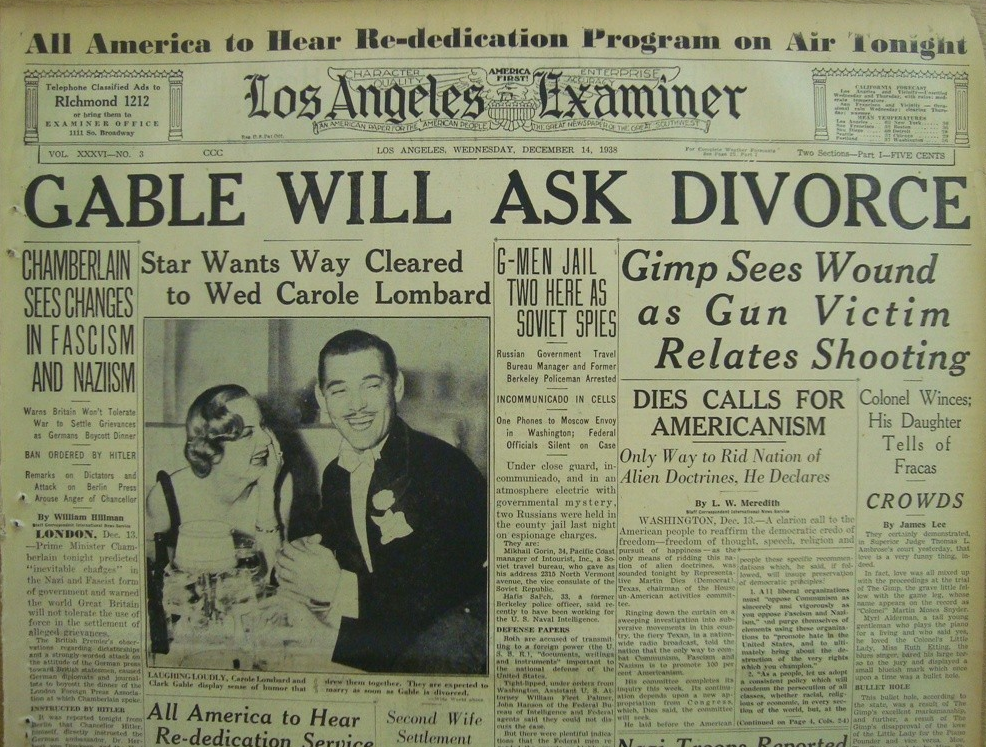
Despite claims that their wedding night was spent in Oatman, Arizona, the newlyweds drove home immediately afterward, arriving in Los Angeles at 3:00am. After a few hours sleep, the publicity department at MGM had arranged for them to have a “meet and greet” with the press on the front lawn. Clark answered most of the questions, usually with “No comment” as they got too personal. Carole giggled nervously. No matter which paper you read that covered the event, they all had the same conclusion: These two were smitten!
Married Life
Called the “romance of the century” and “the greatest couple ever paired” by gushing fan magazine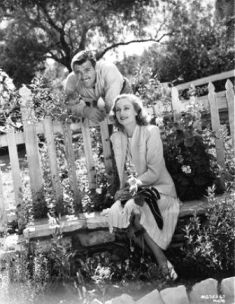 columnists, the Gables (calling each other “Ma” and “Pa”) settled quickly into a life that revolved around their ranch. Shunning most Hollywood invitations, they preferred to spend their evenings at home with only their closest friends. Glamorous Carole was now at her happiest trudging along with Clark in the mud, toting guns and heavy equipment on hunting trips. She became quite an excellent shot and bragged that she became even better than Clark! Although women were not usually welcome on these hunting and fishing excursions, Carole soon proved herself to be one of the guys.
columnists, the Gables (calling each other “Ma” and “Pa”) settled quickly into a life that revolved around their ranch. Shunning most Hollywood invitations, they preferred to spend their evenings at home with only their closest friends. Glamorous Carole was now at her happiest trudging along with Clark in the mud, toting guns and heavy equipment on hunting trips. She became quite an excellent shot and bragged that she became even better than Clark! Although women were not usually welcome on these hunting and fishing excursions, Carole soon proved herself to be one of the guys.
They both took pride in the ranch. Carole decorated the interior and remodeled the rooms just to satisfy Clark’s taste. Carole did have an exquisitely girly bedroom and bathroom to herself, which in usual Carole fashion she referred to as “the fanciest shithouse in the country!” They had horses, chickens, dogs and cats, all lovingly cared for. Carole bought Clark a tractor and he was always harvesting and gardening when his schedule permitted it. They did all the work themselves, having only one caretaker and a personal secretary, Jean Garceau, to help with administrative duties. One afternoon when they were sitting on the patio watching the sun go down, Clark became emotional and said, “Ma, we’re lucky people. We’ve got this ranch, and while it’s not going to support us, it feels like a ranch, it smells and looks like a ranch. It’s not just animals and hay. We’ve got the house fixed just to suit us, we’ve both got good jobs, friends, money in the bank and our health. God’s been good to us. Can you think of anything you really want that you haven’t got?” Carole thought for a minute before answering. “Pa, to tell you the truth, I could use a couple of loads of horse shit if we’re going to do any good with those fruit trees.”
 The two were fond of gags and were often trying to one-up each other. Carole knew that Clark was sensitive about the box office failure of his film Parnell. She had Parnell posters plastered all over MGM so he would come face to face with them wherever he went. To get her back, for a one year anniversary present, he gave her a custom made gown designed by Adrian, with newspaper headlines plastered all over it: “Parsons Pans Lombard!” “Lombard Flops Again!” “Lombard Limited–And How!” “Critics Cauterize Carole!” Carole, head held high, defiantly wore the gown to the next formal party they attended, despite Clark’s protests.
The two were fond of gags and were often trying to one-up each other. Carole knew that Clark was sensitive about the box office failure of his film Parnell. She had Parnell posters plastered all over MGM so he would come face to face with them wherever he went. To get her back, for a one year anniversary present, he gave her a custom made gown designed by Adrian, with newspaper headlines plastered all over it: “Parsons Pans Lombard!” “Lombard Flops Again!” “Lombard Limited–And How!” “Critics Cauterize Carole!” Carole, head held high, defiantly wore the gown to the next formal party they attended, despite Clark’s protests.
During filming on Idiot’s Delight, Carole worked at helping Clark feel relaxed and confident about his dancing. She sent him a full ballet outfit, including some over-sized dancing slippers, and when the dance sequences were finally shot, she had a huge bouquet of flowers delivered to him, prima ballerina-style.
While Clark was having grand success on the heels of Gone with the Wind, Carole switched gears and tried her hand at dramas, none very successful. She gradually slowed down on making movies and concentrated on trying to get pregnant. After two years of trying, she was very frustrated. She always got what she set out to achieve and the fact that motherhood alluded her was disturbing. The pair even visited John Hopkins Hospital in Washington DC to test their fertility. Friends say it was beginning to crack the Gables’ marriage.
An Untimely End
When the Japanese attacked Pearl Harbor in December 1941, both Clark and Carole felt they must do something for their country. At Carole’s urging, Clark was elected President of the Hollywood Victory Committee. One of his first duties was to set up war bond rallies. He didn’t like the idea of traveling to his hometown in Ohio (he despised crowds) but Carole jumped at the chance to visit Indianapolis. Clark had to report to the set to film Somewhere I’ll Find You, so he couldn’t go with her. In his place he sent his friend and MGM publicity man, Otto Winkler and Carole’s mother Bessie volunteered to join them.
Jean Garceau recalled that Carole looked particularly sad when she was leaving the ranch. She gave Jean a big hug and said, “Take care of Pa for me.” and gave her several little notes, one for each day she would be gone, to give Clark. Clark was absent when the three boarded the train at Union Station on January 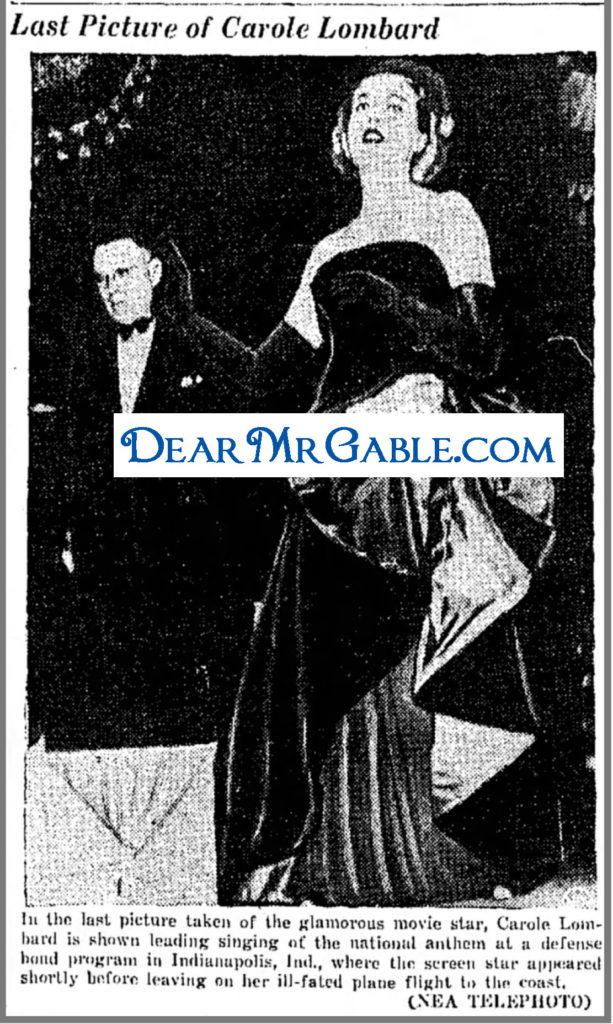 12, 1942, some say because of an argument they had had the previous evening when she had warned him of cheating on her while she was gone. Carole arrived in Indianapolis on January 15 and regaled the crowd with a patriotic speech. She stationed herself in the statehouse, signing autographs and chatting with anyone who bought war bonds. One asked, “Where’s Clark?” She quipped, “At home. One of us has to work!” The Treasury Department had given her a quota of $500,000 of war bonds to sell. At the end of the day she had sold $2,017,513.
12, 1942, some say because of an argument they had had the previous evening when she had warned him of cheating on her while she was gone. Carole arrived in Indianapolis on January 15 and regaled the crowd with a patriotic speech. She stationed herself in the statehouse, signing autographs and chatting with anyone who bought war bonds. One asked, “Where’s Clark?” She quipped, “At home. One of us has to work!” The Treasury Department had given her a quota of $500,000 of war bonds to sell. At the end of the day she had sold $2,017,513.
The trio was supposed to leave by train on the morning of January 16, make two more stops in Kansas City and Albuquerque, and arrive in Los Angeles on January 21. Carole suddenly decided that she couldn’t continue the tour and that she wanted to get home as soon as possible. Her mother had never flown before and was terrified. An avid believer in numerology, she was especially frightened after realizing that the flight was TWA #3, the plane was a DC-3, they were traveling in a party of three and that Carole was 33 years old. Three was very unlucky. Carole laughed off her mother’s protests and agreed to a coin toss. Carole won and they boarded the flight that very evening. At a fuel stop in Albuquerque, the pilot asked Carole, Bessie and Otto if they would mind relinquishing their seats to three servicemen and catch a flight the next day. Uncharacteristically, Carole refused; she was too anxious to get home. They were due to arrive in Los Angeles at 8:45am.
Clark had missed Carole terribly and made sure the house was in perfect order. He planned a surprise party for the returning trio and had the house decorated in red, white and blue streamers and balloons. He knew that the airport would be swarmed with press for her arrival, so he chose to stay home and wait for his wife. He received a phone call from MGM executive Eddie Mannix, around the time the plane should have landed. He told Clark that Carole’s plane had gone down outside of Las Vegas. Nobody knew the condition of the plane or the passengers, but he had already chartered a plane and suggested they get to Las Vegas immediately. Clark, Eddie, Otto’s wife Jill and Carole’s brother Stuart boarded the plane to Las Vegas just an hour later. When they arrived, a rescue team was already headed up Mount Potosi (or Table Rock Mountain, as locals called it) and all they could do was wait for word. Clark insisted on going up the mountain, he could see the burning wreckage and was anxious. Eddie, knowing better, dissuaded him. Eddie joined the rescue party for the fifteen hour trek and later said what he saw in the blood splattered snow “was something that has always haunted me.” He sent Clark a telegram as soon as he could, “No survivors. All killed instantly.” Eddie brought back a piece of one of Carole’s ruby clips that Clark had given her just that past Christmas, and a long lock of her blonde hair. Clark held out the hope that her wedding band would be found, even offering a reward, but it never was.
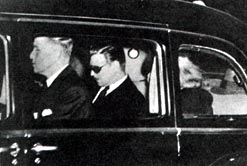 A devastated Clark headed back to Los Angeles with the bodies of his wife, his mother-in-law and his friend. He bought three crypts at Forest Lawn in Glendale in the Grand Mausoleum, Sanctuary of Trust: one for Bessie, one for Carole and one for himself. A small funeral was held for Carole and her mother on January 21. Clark sat in the front pew and spoke to no one. Carole had requested in her will that she be buried in a white dress by fashion designer Irene. The dress was laid on top of what was left of her body in the coffin.
A devastated Clark headed back to Los Angeles with the bodies of his wife, his mother-in-law and his friend. He bought three crypts at Forest Lawn in Glendale in the Grand Mausoleum, Sanctuary of Trust: one for Bessie, one for Carole and one for himself. A small funeral was held for Carole and her mother on January 21. Clark sat in the front pew and spoke to no one. Carole had requested in her will that she be buried in a white dress by fashion designer Irene. The dress was laid on top of what was left of her body in the coffin.
After the funeral, Clark returned home to their beloved ranch for the first time since Carole’s death. Jean Garceau gave Clark the last note from the ones Carole had left for him. She didn’t know what the note said, but upon reading it, Clark broke down and sobbed. Jean recalled, “Up until then, Clark had borne himself with fortitude and courage, had been stronger than any of us throughout the entire ordeal. After he calmed down, he was again in perfect control, his grief masked. He asked no sympathy, wanted none, was unapproachable.”
Elaine Barrymore (wife of John) perhaps said it best, “Clark adored her. She was the light in his eyes. He admitted to me that he had always loved the company of ladies and he knew he had a reputation of being a ladies man, but with her it was different. He really was in love. To have her taken from him was like someone ripped out his soul. I saw him periodically for years afterward. The light in his eyes was gone. Even when he smiled. That light never returned.”
Carole Lombard’s Last Will and Testament
(click for larger photos)
More Information
Carole Lombard category in blog posts
My visit to Carole Lombard’s grave at Forest Lawn Glendale
My tour of Carole Lombard’s homes in Los Angeles
My visit to Clark and Carole’s home in Encino
Articles in The Article Archive:
Is Carole Lombard In Love At Last? (1936)
A Heart to Heart Letter to Carole Lombard and Clark Gable (1936)
The Evolution of a Wow (1936)
She Gets Away with Murder (1937)
The Utterly Balmy Home Life of Carole Lombard (1937)
How Will the Gable-Lombard Romance End? (1937)
Clark Gable’s Romantic Plight (1937)
Can the Gable-Lombard Love Story Have a Happy Ending? (1938)
Hollywood Diary (1938)
What’s Become of the Good Scout? (1938)
Happiness Ahead for Clark and Carole (1938)
Lombard–As She Sees Herself (1938)
Hollywood’s Unmarried Husbands and Wives (1939)
Hollywood’s Goofy Gal Goes Glamorous (1939)
Will Clark Gable Ever Marry Carole Lombard? (1939)
Lombard Unlimited (1939)
Blonde Beauty Grows Up (1939)
Do Hollywood Women Spoil Their Men? (1939)
Can the Gable-Lombard Romance Last? (1939)
How to Get Your Own Clark Gable (1939)
Best Wishes, Carole Lombard Gable (1939)
Will Carole Lombard’s Marriage End Her Career? (1939)
The Clark Gables at Home (1939)
Our Home, Our Work…and Children (1939)
Subject: Lombard (1940)
Vivien Leigh, Rhett Butler and I (1940)
Mr. and Mrs. Clark Gable (1940)
Two Happy People Part 1 (1940)
Two Happy People Part 2 (1940)
Two Happy People Part 3 (1940)
Two Happy People Part 4 (1940)
Help Kill Crazy Rumors About Me! Says Carole Lombard (Mrs. Clark Gable) (1940)
How Clark Gable and Carole Lombard Live (1940)
At Home with the Gables (1940)
Carole Lombard (1940)
It Looked Good for a Laugh at the Time (1941)
She Knew What She Wanted (1941)
The Gags of the Gables–Like Crazy (1941)
Goodbye, Carole (1942)
What the Loss of Carole Lombard Means to Clark Gable (1942)
Letter to Heaven (1942)
Carole Lombard’s Life Story Part 1 (1942)
Carole Lombard’s Life Story Part 2 (1942)
How Clark Gable is Conquering Loneliness (1942)


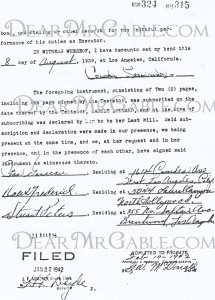
3 Comments
Morris Galloway
Regarding the crash, here are some facts from memory that you may wish to check. The aircraft was owned and flown by TWA. The highest mountain obstacle on the route was 2,800 feet above the surrounding plains. The pilot plotted a course taking the craft over a lower point. However, a navigation error took them right into the mountain. And here is the kicker:
TWA told the pilot to conserve fuel by flying at a lower altitude than the mountain top. Had they spent a few more bucks on avgas and climbed to 3,000 or 3,500 they would have cleared the mountain.
Sorry, I can’t remember the sources for this, but I think it is verifiable, or I would not have mentioned it. Hoping you have a great new year,
I remain,
M. G.
Paladon
I enjoyed reading about their life and love.
Pingback: